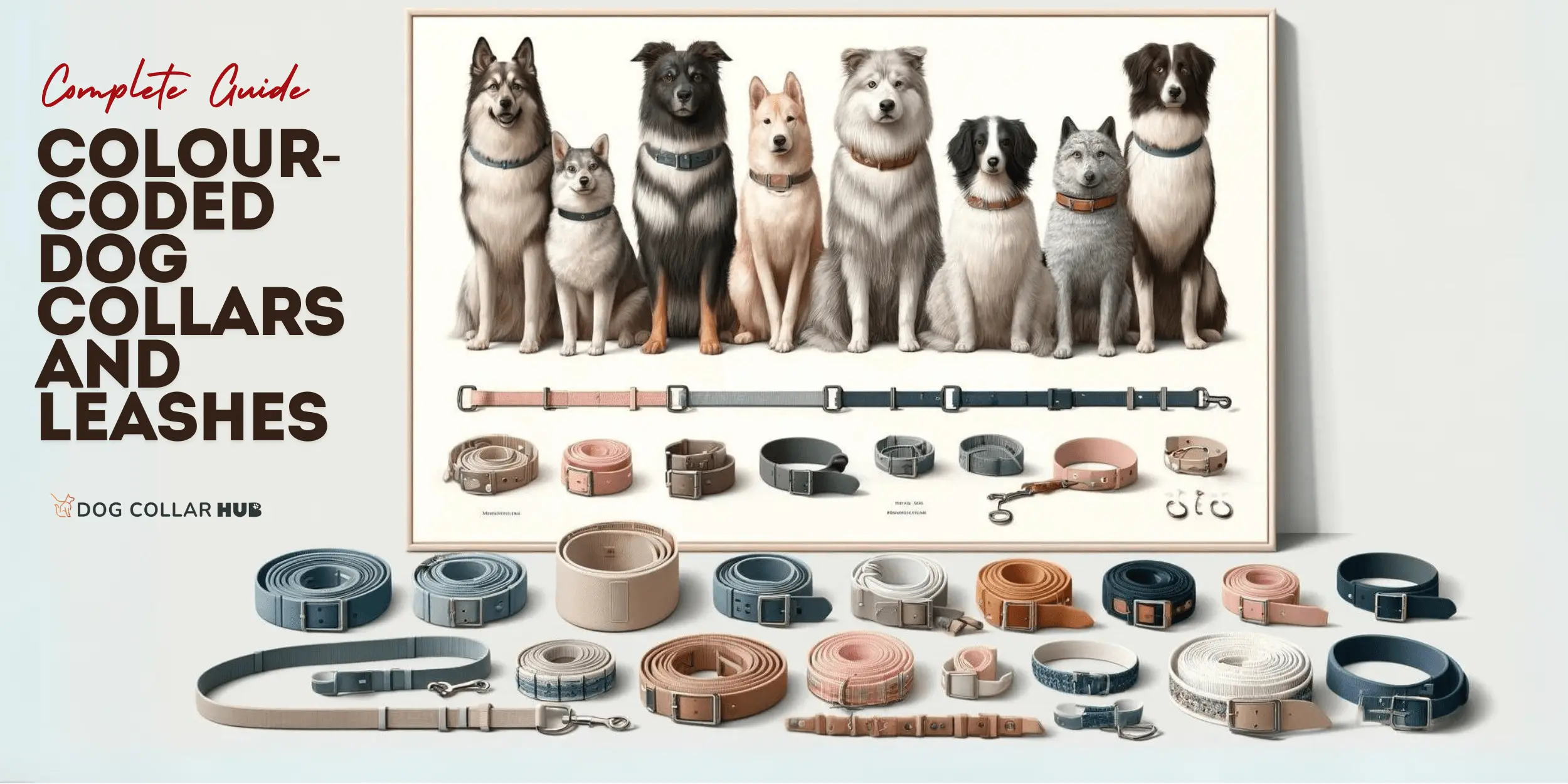As a dedicated pet trainer, volunteer, and pet parent of Daisy and Max, I always find Colour-Coded Dog Collars and Leashes to be extremely helpful.
They are great communication tools that make our walks safer and more enjoyable by providing important information at a glance.
Using colour-coded collars and leashes shows that you’re a thoughtful and informed pet parent, attentive to your dog’s needs.
These tools help you communicate your dog’s temperament or needs to others without saying a word.
Knowing the meaning of each colour can help you avoid potential issues during a walk, ensuring a smooth and stress-free experience for both you and your dog.
This not only enhances your pet care but also reflects your commitment to being a responsible and caring pet parent.
My Discovery of Colour Codes
I first stumbled upon the colour-coded system a few years ago. It fascinated me — a simple, visual cue that could inform me about a dog’s behaviour or needs from a distance.
Genius!

Note: If you want to print the chart in high quality then click here on download and you will get the chart in high quality designed by the Dogcollarhub Team for you.
The Spectrum of Signals
Let’s break down what each colour signifies:
Red: Caution – Do Not Get Close!
Red is a universal sign of caution, and in the canine world, it means the same. A dog with a red collar or leash may need more space and could be reactive or aggressive. In my experience, giving the dog and their owner room to pass without approaching is a clear sign.
Orange: No Dogs – The Dog is Not Friendly!
Orange indicates that a dog is not friendly towards other dogs. When walking Max, who’s always eager to greet fellow canines, spotting an orange collar or leash tells me to steer clear and respect the other dog’s space.
Green: Friendly – You Can Get Close!
Green is the ‘go-ahead’ signal. A dog wearing green is generally friendly and open to greetings. However, I always remind others that, just like with people, it’s polite to ask before approaching, even with a green signal.
White: Deaf or Blind – Require Special Approach!
White indicates that a dog may have impaired sight or hearing. I’ve learned that these dogs require a special approach, usually involving more patience and gentle handling.
Bright Yellow: Adoption – Looking for New Home!
A bright yellow collar or leash often means the dog is looking for a forever home. This is a wonderful conversation starter for potential adopters to learn more about the dog.
Light Yellow: Nervous -Dog Needs Space!
Light yellow signals that a dog is nervous or anxious. I remember the first time Daisy wore a light yellow ribbon; it helped others understand her timid nature during her socialization training.
Blue: Training or Service – Do Not Approach without the owner’s consent!
Blue indicates a dog in training or a service dog. It’s essential to ask the owner before interacting, as these dogs are working and should not be distracted.
Purple: Do Not Feed
Purple is an important colour indicating that a dog should not be fed, perhaps due to dietary restrictions or health issues. When Max was on a strict diet, his purple leash was a clear indicator to kindly decline any treats offered by well-meaning strangers.
My Chart for Reference
In my years of working with dogs, I’ve created my quick-reference chart that hangs by the door:
| Colour | Meaning | My Action Plan |
|---|---|---|
| Red | Caution | Keep Max close, avoid close encounters |
| Orange | No Dogs | Steer Daisy clear of canine company |
| Green | Friendly | Allow greetings and sniffs |
| White | Deaf/Blind | Approach with gentle, visible cues |
| Bright Yellow | Adoption | Encourage people to interact and inquire |
| Light Yellow | Nervous | Give a wide berth, move calmly |
| Blue | Training/Service | Maintain distance, respect the work |
| Purple | Do Not Feed | Avoid giving treats, no matter the puppy eyes |
Ribbons and Bandanas: My Go-To Accessories
Ribbons and bandanas are my go-to, especially for community events where Daisy and Max interact with many people.
They’re also handy when I’m working with clients’ dogs to signal specific needs without having to explain them constantly.
Always Ask: My Golden Rule
Even with all this colour communication, my golden rule is always asking before approaching a dog. It’s a sign of respect for the owner and the animal. The colours help, but they don’t replace good old-fashioned verbal communication.
Sharing the Knowledge
My role as a trainer and a pet owner is to educate others about these colour codes. The more we know, the safer and happier our pets will be.
I always share this knowledge with new dog owners and even seasoned pet parents who might not be aware of this system.
Final Thoughts
This colour-coded system has been a game-changer for me, Daisy, and Max.
It’s all about creating the best possible interactions and ensuring everyone’s comfort and safety.
By understanding and using these colours, we’re all taking an active role in responsible pet ownership — and that’s something to be proud of.


